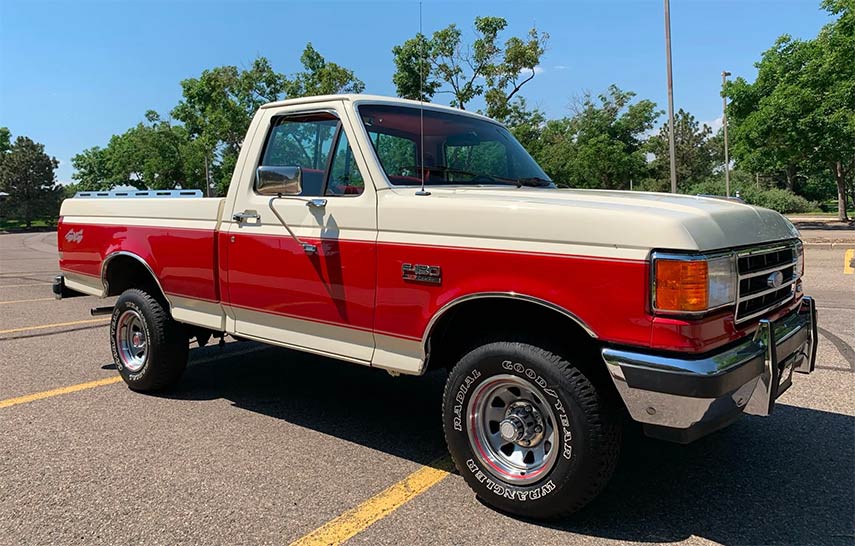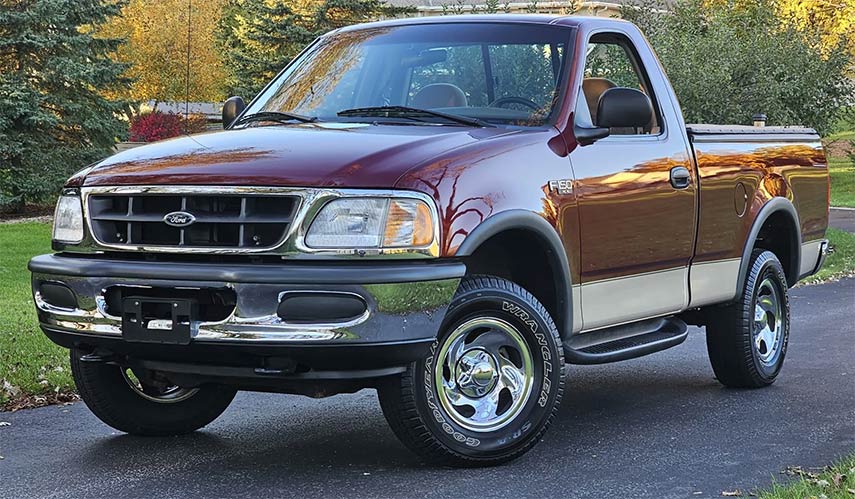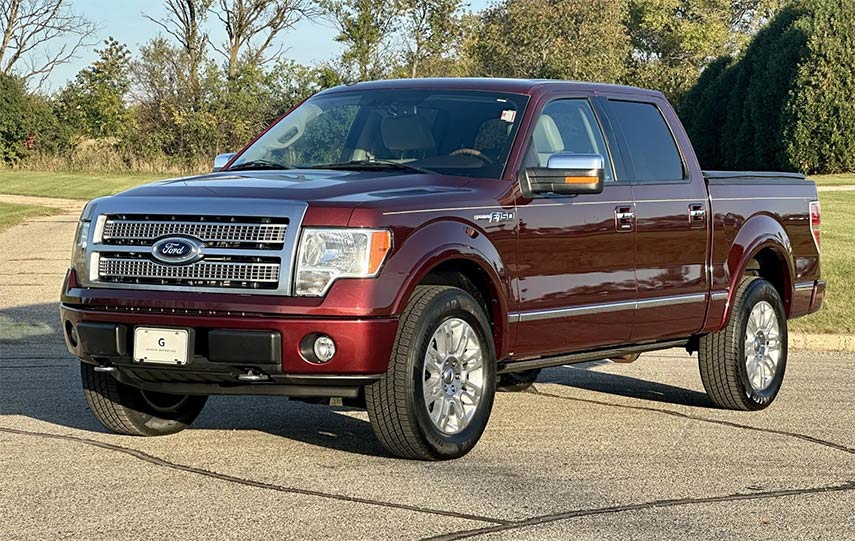The Ford F-150 is the best-selling vehicle in America and has been for several decades running. It originally started as part of the F-Series trucks that debuted in 1948. The F-Series was marketed as a full-size pickup model that was bigger than the compact Ford Ranger.
Starting in 1953, the naming convention for the F-Series model line includes the F-100, F-250, and F-350.
However, the actual F-150 didn’t come out until 1975. It was sold as a slightly larger model than the F-100 until 1983 when the F-100 was discontinued. Since then, the F-150 has gone on to become the ubiquitous American truck.
First Generation Ford F-150: 1975-1979

1976 Ford F-150 XLT Trailer Special. Source: Bring A Trailer
The first generation of the Ford F-150 was introduced in 1975 as part of the sixth generation of the F-Series trucks. It slotted in over the F-100 and beneath the larger F-250. The F-150 for this generation offered both regular and super cab layouts.
The base engine was an inline-six that made a mere 113 horsepower, but there were two V8 engines available that made 145 and 160 horsepower respectively.
Another V8 engine came out in 1976 and gained a small power boost in 1977. The original first-generation F-150 came with round headlights, but rectangular headlights became the norm in 1978.
A three-speed manual transmission was standard, and an automatic transmission was optional.
Second Generation Ford F-150: 1980-1986

1983 Ford F-150 Standard. Source: Bring A Trailer
The second generation of the Ford F-150 arrived in 1980 as part of the seventh generation of the F-Series. It looked a bit different than the first generation with an egg-crate grille, but it kept the rectangular headlights.
Other improvements included a more refined ride and a lighter chassis. The inline-six engine remained the standard base powertrain and two V8 engines were available.
In 1981, Ford introduced a four-speed manual transmission as standard equipment and an optional four-speed automatic transmission. In 1985, fuel injection was introduced on the F-150’s engine options.
The Blue Oval emblem debuted in this generation for the 1982 model year.
Third Generation Ford F-150: 1987-1991

1988 Ford F-150 XLT Lariat. Source: Bring A Trailer
For the third generation, the F-150 featured a more streamlined look than the boxy profile of previous generations. The engine and transmission options remained the same with slight horsepower gains.
Ford made further improvements to the ride dynamics of the F-150, making it far more livable as a daily driver or family vehicle. Regular and super cab layouts were available.
For the 1988 model year, a five-speed manual transmission came out to replace the four-speed as standard equipment. Buyers still had the option of a three or four-speed automatic transmission as well.
In 1991, The F-150 Nite Edition came out for the first time. These were 4WD XLT Lariat models with a blacked-out aesthetic.
Fourth Generation Ford F-150: 1992-1996

1992 Ford F-150 XLT Nite Edition. Source: Bring A Trailer
Compared to the third generation, the fourth generation of the Ford F-150 took on an even more aerodynamic look with rounded edges. The choice of powertrains remained the same with a base inline-six and then two V8 engines.
Four and five-speed manual transmissions were available alongside a three or four-speed automatic.
The SVT Lightning took the place of the Nite Edition in 1993 as a sporty model with upgraded tuning for the 5.8-liter engine. In 1995, the F-Series trucks became the world’s best-selling vehicle, beating out the VW Beetle. 1995 was also the last year for the inline-six engine.
Fifth Generation Ford F-150: 1997-2003

1998 Ford F-150 XL. Source: Bring A Trailer
The fifth generation of the Ford F-150 came as part of the tenth generation of the F-Series. This truck featured a much sleeker appearance than the earlier generations. It was arguably the most dramatic redesign of the truck to this point.
The rounded look was more appealing as a family vehicle and it added to that with a lighter chassis. Powertrain options were also drastically changed with a 4.2-liter V6 engine becoming the standard base engine. Two V8 options were also available.
A five-speed manual transmission remained standard, but an automatic transmission was available as well. The Super Crew Cab was introduced for this generation and it was a true four-door layout that would later become the norm. The range-topping King Ranch trim was also introduced for this generation.
Sixth Generation Ford F-150: 2004-2008

2007 Ford F-150 Lariat SuperCrew. Source: Bring A Trailer
As part of the 11th generation of the F-Series, the F-150 was introduced in 2004 for its sixth generation. The exterior was again redesigned to make the headlights more square and slightly sharper angles were added to the previous rounded body design.
Both regular and crew cab options featured four doors to make the F-150 even more family-friendly.
The base V6 engine carried over with a five-speed manual transmission. The 5.4-liter Triton V8 was paired only with an automatic transmission as an optional powertrain.
The sixth generation of the Ford F-150 offered a choice between 6.5-foot or 8-foot beds and the interior was vastly upgraded as well. These changes cemented the F-150 as both a work truck and a family vehicle.
Seventh Generation Ford F-150: 2009-2014

2009 Ford F-150 Platinum Crew Cab. Source: Bring A Trailer
By the seventh generation of the Ford F-150, the truck began to take on the design cues that can be seen in today’s models. This includes a fully boxed frame and a redesigned body shape. Inside, more modern tech and luxury features became the norm.
A selection of all-new engines became available, starting with the 3.5-liter turbocharged V6. A 3.7-liter V6 was also available, plus two V8 options.
This was the generation for the SVT Raptor, which has continued to attract off-road enthusiasts. It started with a 5.4-liter Triton V8 but was eventually upgraded to a 6.2-liter V8 that made 411 horsepower.
In 2014, the F-150 Tremor became available with the 3.5-liter engine as its powertrain. This was primarily an appearance package based on the regular cab layout.
Eighth Generation Ford F-150: 2015-2020

2017 Ford F-150 Raptor SuperCab. Source: Bring A Trailer
For the eighth generation of the F-150, Ford made a big announcement that it was using aluminum for the truck’s body panels. The goal was to make the truck lighter and improve fuel economy.
This F-150 was still larger than previous generations and featured several engine choices, including a 3.0-liter turbodiesel. Regular, crew cab, and super cab layouts were available.
Another first for the F-150 was a five-star NHTSA safety rating and it continued to be the best-selling vehicle in the United States. The Raptor was also revised in 2017 and added a more powerful V6 engine that made 510 horsepower.
Ninth Generation Ford F-150: 2021-present

2021 F-150 Lariat SuperCrew
As of this writing and the 2025 model, the Ford F-150 is still in its ninth generation. It was redesigned in 2021 and in 2022 it added new powertrains, including a hybrid, diesel, and the fully electric F-150 Lightning.
For the 2024 model year, the F-150 got a midcycle refresh with new design elements, new technology, and standard 4WD on trims starting with the Lariat. The 3.3-liter V6 and the Super Cab truck with the 8-foot bed were removed from the lineup.
If you have a sixth generation or newer F-150 in your garage, you can protect the truck bed with a Ford F150 bed liner from DualLiner. No other truck bed liner system is as comprehensive, secure, and easy to install as DualLiner. But don’t just take our word for it, it’s Cars.com choice for their F150 as well.

2020 Ford F150 DualLiner Truck Bed Liner



